Introduction to PAX
TV program
[This was the very first national TV program that has
mentioned that the late Ron Wyatt was the very first person to visit Jebel el
Lawz and identify it as being the real Mount Sinai. The segment on this
program that features Bob Cornuke's and Larry Williams' comments are from their
old interviews from 1993-1998, and in those interviews they never mentioned that
Ron Wyatt had been to Jebel el Lawz first - but now the truth is beginning to be
told, it was Ron Wyatt who discovered that Jebel el Lawz is the real Mt. Sinai!
Ron even appeared on the CBS Morning News on
 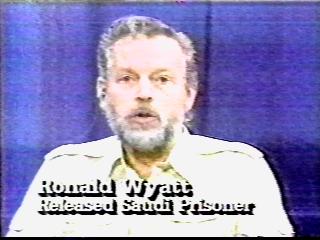
April 18, 1984, with his two sons, and informed the
world about his discovery, but hardly anyone remembers this national television
interview. "It was a letter penned by one of Wyatt's associates that
helped Cornuke and Williams find Jabal al Lawz, which Wyatt had concluded in
1984 was Mount Sinai" Denver Post 10-11-98. William Fry, who is interviewed
in this program, was a co-worker with Ron Wyatt and operates the anchorstone.com
web site.]
The REAL Mount Sinai on PAX Television
Encounters With The Unexplained
November 9, 2001
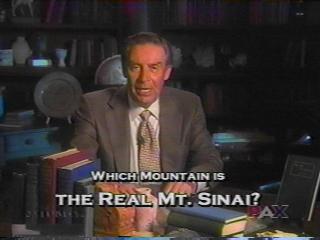
Jerry Orbach: Two of the world's great religions,
Christianity and Judaism, base many of their beliefs, even their geopolitical
systems on events and declarations from Mount Sinai. But nobody seems to
know exactly where Mount Sinai is. Is there a real mountain that holds the
secrets of God's interaction with man? Were the tablets of the Ten
Commandments literally carved by the finger of God into stone from this
mountain? New information seems to indicate that the real Mount Sinai is
in Saudi Arabia, and interestingly enough, the Saudi Arabian Government has
erected a chain link fence and closed down all geological and archaeological
excavations on this mountain in the ancient land of Midian. Since the
fourth century AD, a high mountain near the southern end of the Sinai Peninsula,
officially labeled Jabal Musa, has been regarded by many faithful Christians as
THE Mount Sinai. But is it?
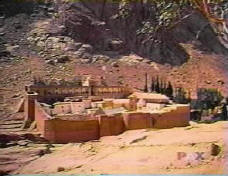
Saint Catherine's Monastery located at
the base of the mountain, was constructed by order of the Emperor Justinian
between 527 and 565 AD. It's built around, what is thought by those who
inhabit the monastery and many in the surrounding area, the bush Moses saw
burning but not consumed. By order of Queen Helena, mother of the Emperor
Constantine, a chapel was built over the very bush centuries ago. This
monastery is in fact, a spectacular natural setting for the second largest
collection of illustrated manuscripts in the world. A collection exceeded
only by the Vatican's.
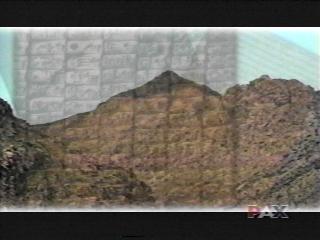
But if so many generations of rulers, priests and
kings are satisfied with this Mt. Sinai, what is it that makes today's scholars
and investigators turn their attention to a mountain in Saudi Arabia called Jebel
el Lawz?
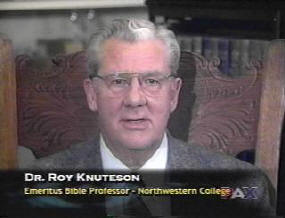
Dr. Roy Knuteson: None of the suggested sites in the
Sinai Peninsula fit the biblical requirements. The traditional site called
Jebel Musa, and located near Saint Catherine's Monastery, fails all of the
historical, geographical and archaeological tests.
Orbach: Perhaps we should take a moment to discover
exactly what these tests are and how they can be applied some 4,000 years after
the fact. To summarize the story briefly, a young Moses raised as an
Egyptian Prince was forced to flee into the desert to escape the rath of Pharoah
after he killed an Egyptian overseer who was beating a Hebrew slave.
Eventually he came into the camp of a Midianite priest named Jethro, who was
wealthy in both daughters and livestock. Moses married one of Jethro's
daughters Zippora, and settled down to what he thought would be the life
of a shepherd, but it was not to be. One day while grazing his flock on
the slopes of Mount Sinai, he encountered a most marvelous site, a bush suddenly
burst into flames, but it was not consumed, and out of the burning bush, Moses
heard the voice of God, "I am the God of Abraham, Isaac and
Jacob." The life of Moses would never be the same. The
Lord told him to return to Egypt and bring the Hebrews out of bondage.
This was to be the great exodus out of Egypt and into the promised land.
The story of the burning bush as well of other miracles performed by Moses in
his effort to get the Pharoah to release the Hebrew slaves, had been the cause
for a great deal of skepticism over the centuries, and many critics
question whether there ever was a massive exodus out of the land of Egypt.
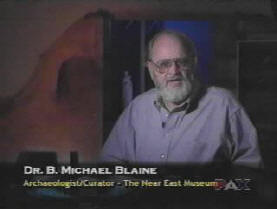
Dr. B. Michael Blaine: The
biblical story of the Exodus is an eyewitness account, written by a layman to
his contemporaries. Although the writer was not a scholarly historian,
there are enough historical kernels indicating the account is factual from both
an archaeological and Egyptian anthropological perspective. The account contains
sufficient place names cross referenced in non-biblical Sumarian and Assyrian
Cuniform tablets to confirm the accuracy of the exodus account and to assure
scholars that it was not an account invented for later consumption.
Orbach: Few places mentioned in the Bible are as
important to the people of that book as Mt. Sinai. Virtually every major
event associated with the exodus, somehow involves this Holy mountain.
That being the case, certain identifying characteristics are required by the
biblical account that can help us pinpoint the location of Mt. Sinai, but what
are they?
Knuteson: First it had to be located in ancient Midian,
which is in present day Saudi Arabia. Secondly, on the back side of the
mountain there must be a vast desert as you see here.
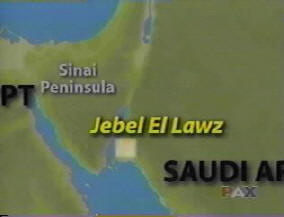
Thirdly, it must be
located completely outside of Egypt and its controlled territories which would
exclude the Sinai Peninsula. None of the other proposed mountains fits all
these requirements except Jebel el Lawz.
Orbach: But if that is true, how did Jebel Musa and
the site of Saint Catherine's Monastery get such a hold on the popular and
scholarly imagination?
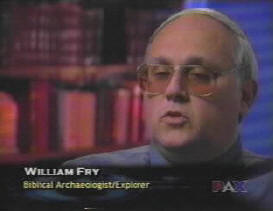
William Fry: Unknown to most people, the Jebel
Musa site was selected solely on the opinion of one man, or perhaps we should
say one man's mother. The Roman Emperor Constantine the Great, sent his
mother Helena to the Middle East to discover spots he had seen in visions.
Helena ordered a church built on the spot where fourth century Bedouins said they
had found the burning bush. What we must understand is that Mt. Sinai in
the Sinai Peninsula was selected without any scientific or archaeological
evidence being considered.
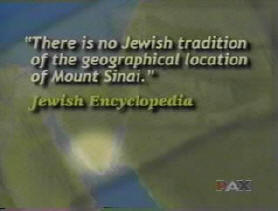
Orbach: There doesn't seem to be any firm Jewish
tradition which supports Constantine's site either, in fact the Jewish
Encyclopedia states flatly that there is no Jewish tradition of the geographical
location of Mt Sinai. But that also means there is no tradition that
supports the site in Saudi Arabia. What is it that points scholars to this
site?
Fry: The earliest Jewish source, other than
the Torah, that discusses the location of Mt. Sinai is the Septuagint, the Greek
translation of the Hebrew Bible begun in the third century BC. The
Septuagint transliterates the Hebrew name for Midian as either Madian or Madiam.
The Septuagint states that Jethro was the priest of Madian, who went out and
then went into the desert to meet Moses.
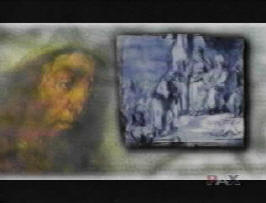
The location of ancient Madian
can be determined from a map produced by Tolime, a second century AD geographer
in Alexandria.
Orbach: And the Septuagint is not alone in placing
the mountain near a city in modern day Saudi Arabia. Demetrias the
chronographer in the third century BC, claims that after Moses married Zippora
they made their home in the city of Madian. And Philo, a Jewish
philosopher, describes Zippora as an Arab who lived in Arabia. He
describes the Israelites wandering eastward all the way across the Sinai
Peninsula to the southern edge of Palestine, just before the revelation in
Sinai.
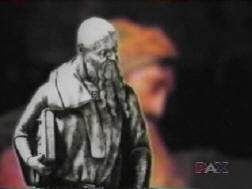
Philo thus places Mt. Sinai somewhere in Northwestern Arabia.
Philo adds one more small detail to the investigation of Mt. Sinai, he says that
Moses went up the highest and most sacred of the mountains its region.

But it is
the Apostle Paul who provides the finishing touch. In Galatians 4:25 he
says, "Now Hagar stands for Mt. Sinai in Arabia." Where does
that leave Jebel Musa, or the present Mt. Sinai? Since 1956,
archaeological teams have searched for evidence that Moses and the Israelites
once camped here for nearly a year after their flight from Egypt.
Fry: When the Sinai Peninsula was under
Israeli control, they discovered nothing out of over 8,000 inscriptions from the
southern half of the Sinai Peninsula, only a handful are Hebrew Aramaic.
The tradition of identifying one of the mountains in the Sinai Peninsula as the
mountain of Moses was a scholar's invention without any Jewish precedence
whatsoever. No Jews were ever interested in the Sinai Peninsula, with any
respect anyway to Moses.
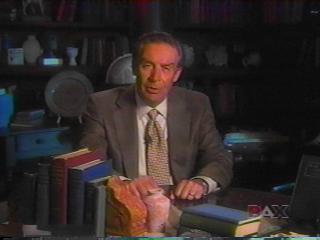
Orbach: Traditions, particularly religious
traditions, die hard. The Mt. Sinai located near the monastery of St.
Catherine is now anchored in 1600 years of tradition and those who are devoted
to this site show little interest in looking elsewhere. Is there some
scientific evidence that proves Jebel el Lawz in northwestern Saudi Arabia is in
fact the true Mt. Sinai? What is there beside just the location to suggest
this mountain was once the place where God communicated directly with
Moses? Has anyone actually been there to see and catalog the
evidence. And, what does the Saudi Government think of all this newfound
attention? Exciting and surprising answers when we come
back..... Most of the places mentioned in Exodus are unknown.
Scholars and investigators are still searching for the point for which the
children of Israel may have crossed the Red Sea. No one knows where they
might have first set foot in Sinai, and the location of the mystical Mt. Sinai
itself is the subject of relentless argument. Lately however, modern
technology has begun to have an impact on the discussion. Infrared
satellite photography for example is helping to provide a clearer picture of the
actual location of this fabled mountain.
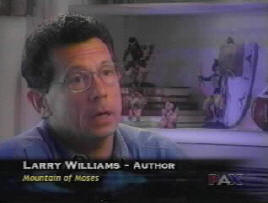
Larry Williams: With satellite infrared photography,
there have been major archaeological discoveries found throughout the
world. There is a trail that comes down the west branch of the Red Sea,
uh, the left hand branch of it, comes down to the tip of the Sinai Peninsula,
stops there, [The Wyatt Group disagrees with this satellite scenario] appears to come out the other side and wanders north to the highest
mountain, Jebel el Lawz. And we did find what I think is important
archaeological evidence that something took place at Jebel el Lawz.
Orbach: Larry Williams, who might best
be described as an adventurer, as apposed to say an archaeologist or scientist,
enlisted the services of Robert Cornuke, a former policeman with a reputation
for bravery, and the two men literally sneaked into Saudi Arabia and made their
way to the mountain called Jebel el Lawz on modern maps, but which four years
earlier had been described as the real Mt. Sinai by amateur archaeologist Ron
Wyatt. [This was the first time that Ron Wyatt's name was mentioned on
national TV in regard to the discovery of Mt. Sinai.]
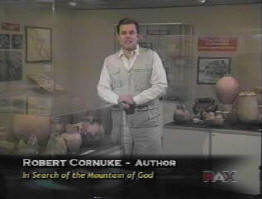
Bob Cornuke: In 1988, we
retraced the exodus route from the tip of the Sinai Peninsula into Saudi Arabia
using the Bible and satellite imagery to find the actual route.
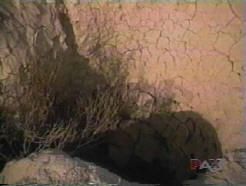 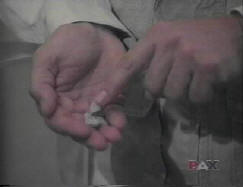
Inland, 33
km, we found the bitter springs of Mara mentioned in Exodus 15. This dirt
sample from the springs has been chemically analyzed and was found to contain
excessive iron and dissolved salts, making it very bitter.
 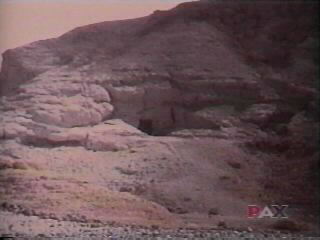
Continuing
along the route we came to the clear water springs mentioned in Exodus 15:27,
here caves were being excavated by Saudi archaeologists. They said they
had found writing in these caves indicating that Moses had come through this
area. The tomb of Jethro, the father-in-law of Moses, and Zippora, the
wife of Moses were found in these caves.
Williams: And we did find what I think is
important archaeological evidence that something took place at Jebel el Lawz.
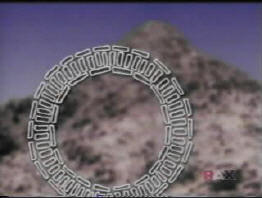
We found at the base of this mountain twelve pillars eighteen and a half feet in
diameter. Why not seven, why not eleven, why twelve? With the twelve
tribes of Moses fitting so perfectly into that scenario.
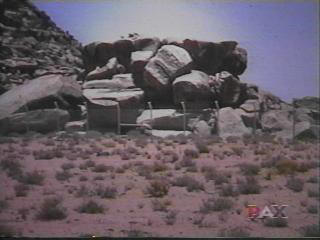 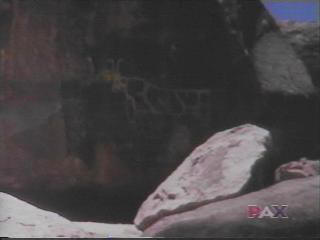
Additionally on
the flat in front of this mountain we found a large pile of rocks about 20-24
feet tall. There is a petroglyph of an Egyptian, not an Arabic drawing,
but an Egyptian drawing of the golden calf. Additionally at the base of
the mountain we found kind of a wing shaped formation, foundation, pointing
toward the mountain
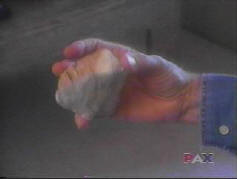
and there we found marble, round marble stone. This is
some of the stone of it. This rock is not indigenous to that area of Saudi
Arabia, let alone to Saudi Arabia.
Orbach: An encampment area large enough for an
estimated one to two million people is a major factor in determining the
location of the real Mt. Sinai. And a source of water for a group that
large would be essential for an extended stay of even a month, let alone a
year. But the Bible provides other clues as well. How does Jebel el Lawz measure up in some of these more obscure requirements?
 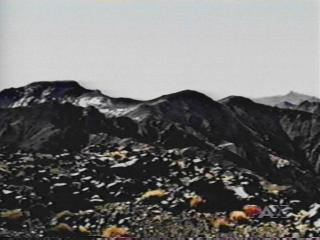
Cornuke: We found the top of the mountain
to be black, as if the rocks had been burnt, possibly confirming biblical
scripture that the Lord descended upon it in fire and smoke.
Orbach: Archaeologists have identified another
small footnote to the Mt. Sinai argument having to do with the tablets of the
Law or the Ten Commandments.
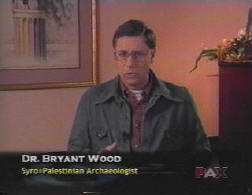
Dr. Bryant Wood: Unlike other law codes, such as
the code of Hammurabi , which was written on an eight foot stele and stood out
in the open air, the Ten Commandments tablets were portable and designed
to be kept as a sacred treasure. Although ancient Egyptian and Babylonian
steles, tablets and wall reliefs were usually done in limestone, basalt rock or
deerite, there is strong evidence the Ten Commandment tablets were done in
granite or marble, rock types that are found at the Jebel el Lawz, Mt. Sinai
site in Saudi Arabia.
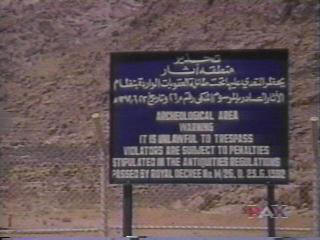 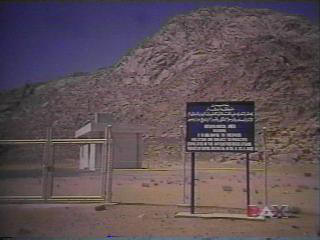
Orbach: Shortly after Cornuke and Williams visited
this site, the Saudi government closed down the Jebel el Lawz site to any
foreign archaeological study. They also erected a chain link fence and
placed a military guard around the mountain to prevent even clandestine
exploration of the site. [Correction: The fences that are
around the mountain and the golden calf altar were not put there after
Cornuke and Williams visited the site in 1988, the fences were put up after
Ron Wyatt showed these things to a Saudi archaeologist in 1985 -- which is
why the fences were already up when the 1988 pictures above, were taken by Cornuke
and Williams. Bill Fry, Ron Wyatt's representative who was interviewed on
this program, notified the production company on this mistake after this program
aired, but it is doubtful that the show will ever be re-edited and corrected.]
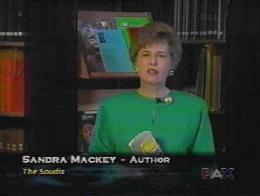
Sandra Mackey: The Saudi government is in
a very difficult political position. Because the Saudi's had no sense of
nationalism when the country was unified in the 1920's, the House of Saud used
the theology of the mojove sect of Islam to create national unity. Saudi
Arabia is still run largely by a coalition between the royal family and the
religious establishment. That religious establishment is very resistant to
exploring anything archaeologically before Islam, a period they see as
characterized by moral chaos. The other problem the House of Saud
faces is external. If it allows archaeological excavations of ancient
Israelite sites in Saudi Arabia, the House of Saud opens itself to the anger of
the Arab world.
Orbach: The evidence of the real Mt. Sinai being
in Saudi Arabia appears to be overwhelming, but the ancient animosities are
still preventing scientists and scholars from uncovering factual evidence that
could settle the matter once and for all. And today's modern warriors are
adding to the difficulty.
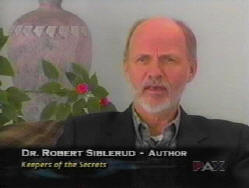
Dr. Robert Siblerud: According to Howard
Blum in his book The Gold of Exodus, any verification of Jebel el Lawz is
going to be very complicated. The mountain is now part of a 5.6 million
dollar Saudi military installation, [The Wyatt Group disagrees with this
assumption, as it is 16 miles away] called operation Peaceshield. It was
built with the approval of the US Congress using US contractors and Air Force
personnel. Operation Peaceshield was originally designed as a radar
installation in order to protect the Kingdom against intruders, however,
according to Blum, there since have been found with missiles capable of hitting
targets in Israel or Iraq. It is ironic that what some investigators lead
to be the true Mt. Sinai, a place where the law was given for the preservation
of Israel could potentially be used for the destruction of Israel.
Orbach: Does this mean then that we may never
really know whether or not this is the Mt. Sinai on which Moses received the Ten
Commandments? Or is there some hope for future exploration?
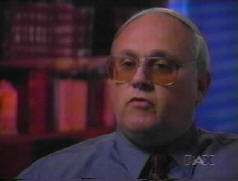
Fry: We need permission for a competent
trained archaeologist to go in and excavate and record the material carefully
and submit it for review by other scholars, because there are too many gaps in
our knowledge.
Orbach: Whether or not this is proven to be the
mountain where Moses stood in awe before the burning bush, there appears to be
considerable evidence that Mt. Sinai is located somewhere in northwestern Saudi
Arabia. And if the Exodus account is true, that mountain will be blackened
by heavenly fire. There will be evidence of a large and sometimes
boisterous encampment, and perhaps as some have suggested, some remnant of the
gold and jewels and other personal possessions the fleeing slaves were allowed
to take with them. Proof positive of the exact location of Mt. Sinai it
seems, is literally hidden behind armed guards of the Saudi Government, but the
earliest post biblical Jewish sources from Palestine, the mid second century
book of Jubilees, fragments of which were found amongst the Dead Sea scrolls,
gives a long and idealized description of geography that suggests the author
believed Mt. Sinai to be in the Arabian Peninsula.
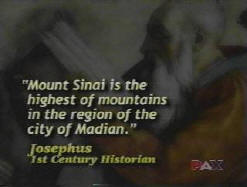
But the clearest
description in the earliest Jewish literature of the location of Mt. Sinai comes
from the first century historian Josephus, he wrote that "Mt. Sinai is the
highest of mountains in the region of the city of Madian." Towering
8,000 feet above the desert floor, Jebel el Lawz certainly fits that
description [It is the tallest mountain in the upper two-thirds of the
country!]. But the sad fact is, despite all the evidence that has been
accumulated we really don't know, and indeed we can't know for certain until
competent archaeological excavations are once again permitted on the mountain
itself. But the presence of a large Arab military installation on the
mountain brings up an interesting question. If Jebel el Lawz was proven to be
the true Mt. Sinai, and the Saudi military was using that strategic location to
direct missiles into Israel, would the Israeli government destroy the mountain
of Moses?
[CLOSING COMMENTS: It is wonderful to see Jebel el Lawz
presented to the world, because it is our firm opinion that it IS the real Mt.
Sinai -- but it is unfortunate that certain individuals have been reluctant to
give the late Ron Wyatt his credit for being the person who truly discovered Mt.
Sinai. If anyone would like to read further about the "problems" that Ron
had for 15+ years with those who attempted to take improper credit for the
discovery, please go to this website:
www.pinkoski.com/sinai.html ]

|

![]()